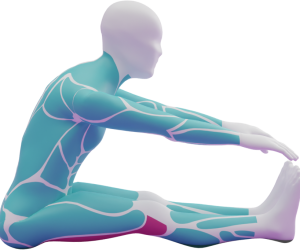
The Optimal Hamstring Injury Recovery
- Noah Soliman
The frequency of hamstring injuries is unsurprising; the constant demands of our hamstrings for accelerating and decelerating when sprinting makes them highly prone to straining. With these injuries taking different forms and severities, it’s easy to feel lost and confused on how to begin your recovery. The last thing we want is for your hamstring recovery to be a passive, ‘sit-on-the-couch’ process, as this will only predispose you to injuring the muscle group again. Therefore, PhysioFrog’s comprehensive rehab for hamstring strains will not only ensure a thorough and fast recovery, but a recovery in which your hamstrings are in a stronger and more resilient condition compared to pre-injury levels.
Anatomy & Function
Before beginning your hamstring rehab exercises, it’s wise to have an anatomical understanding of the hamstrings, as this adds meaning and autonomy to your rehabilitation. Your hamstrings are a group of 3 muscles located at the back of each thigh: bicep femoris, semitendinosus, and semimembranosus.
Responsible for extending the hips and bending the knee, this makes the hamstrings crucial for the sprinting mechanism – specifically the leg’s stabilisation upon ground-contact and the production of energy when ‘taking-off’. This explains why injuries in this muscle group are prevalent amongst sports that require frequent changes of pace, such as soccer and rugby.

Hamstring Strain Symptoms
When you pull a muscle, a significant proportion of your fibres tear, causing an immediate sharp pain. As for the hamstrings, this will occur at the back of the thigh. Other accompanying symptoms: sharp pain during muscle contraction, muscle ache, and a popping sensation.
The severity of the injury is classified into grades:
Grade 1 – small proportion of fibres have torn, mild discomfort.
Grade 2 – approximately half of the fibres have torn, discomfort, and movement negatively impacted.
Grade 3 – complete muscle tear, severe discomfort and swelling.
Timeline for a Pulled Hamstring Recovery
Despite being a common injury, the hamstrings have a great blood supply, making their repair a relatively quick process. Most hamstring recovery timelines last between 3-6 weeks, however some tears can take up to 4 months to completely heal (e.g. hamstring tendon injuries).
An active recovery involves hamstring rehab exercises that aim to stimulate repair of the muscle fibres and regain lost strength, mobility, and endurance so the individual is comfortable and confident to return to competitive play.
RICE Method
The usual protocol for immediately treating a hamstring strain is to apply the RICE method. The function of RICE is to reduce the inflammation period, allowing for the physiological processes involved in recovery to occur.
Rest – stop physical activity to prevent the tear worsening.
Ice – any form of cold will minimise signs of inflammation, such as pain and swelling.
Compression – elastic bandages compressing the affected area will help to decrease swelling.
Elevation – maintaining the injured area at a height level with your heart will further reduce swelling.
This should be done for the first 2-3 days immediately following the injury.
Hamstring Rehab Exercises: Part 1
Following from RICE, you want to begin activating the injured area to refine neuromuscular control and to alleviate any existing pain. The hamstring rehab exercises should be performed with caution and not cause excruciating discomfort.
Below are some exercises aimed at kick-starting your active hamstring recovery. You can follow their animations and further recommendations on the PhysioFrog app:
Get to grips with the physiology and mechanisms behind our warm-ups, and learn how their applications can maximise your on-field performances. Along with the physical benefits of muscle preparation, get an insight into its psychological benefits to truly understand your mind and body!
Get to grips with the physiology and mechanisms behind our warm-ups, and learn how their applications can maximise your on-field performances. Along with the physical benefits of muscle preparation, get an insight into its psychological benefits to truly understand your mind and body!
- Lying Hamstring Stretch – this exercise activates the muscle fibres at every length, reasserting neuromuscular control whilst reducing stiffness.
How to Perform:
(1) Lie on your back with your legs straight in front of you.
(2) Grab your target leg at below the knee, bringing it towards your chest so it’s at roughly a 100-degree angle with the floor.
(3) Point the toes of the target leg upwards and begin to straighten the leg towards the ceiling.
(4) At the top of the movement, rotate the foot downwards.
(5) With the foot in this fixed position, move the lower-leg up and down, taking it through the entire range of motion.

Hamstring Leg Lifts – this exercise is great to re-establish your fibres’ strength and endurance.
How to Perform:
(1) Lie on your back with your feet positioned shoulder-width apart.
(2) Squeeze your butt to lift your lower back so it’s parallel with your legs.
(3) With your heels dug into the ground towards you, raise your non-target leg up so it makes a 90-degree angle with your target leg.
(4) Hold the leg at the top of the movement for a second before returning.

Hamstring Rehab Exercises: Part 2
Once most of the pain has subsided, the focus is now on developing your hamstrings with a ‘return-to-play’ outlook. This means rebuilding any lost muscle strength, mobility, and endurance to a state equal to, or higher, than your pre-injury state. By doing this, you are minimising the re-injury risk and any performance reductions upon your return.
Make sure you can complete these exercises at the highest intensity – with full control and no discomfort. This will signal at your muscles’ preparedness ahead of fast and frequent forces that will be experienced in-game.
Single-Leg Deadlift – this exercise challenges your hamstrings’ (+ glutes) strength and endurance across its entire length.
How to Perform:
(1) Move your non-target leg back as you move forward with your hips till a ‘T’ shape is made with your body.
(2) Point the opposite arm of your target leg downwards to maintain balance.
(2) Balancing on your target leg, keep it slightly bent.
(3) Perform slowly and concentrate your weight on the target leg.

Hamstring Reach Stretch – this exercise will counteract the likely tightness in the hamstrings, resulting in reduced in-game range of motion if unattended to.
How to Perform:
(1) Sitting on your bottom, keep your back straight and legs straight.
(2) Bend through your hips and slowly reach towards your pointed toes.

Conclusion to a Pulled Hamstring Recovery
The excellent blood supply to our hamstrings can encourage complacency in our hamstring injury recovery. However, a passive approach to recovery causes our hamstring to be fragile upon our return to sport – significantly increasing re-injury risk and resulting in a poorer athletic performance. Therefore, it is imperative you follow the hamstring recovery protocol: RICE, followed by PhysioFrog’s muscle mobility, strength, and endurance exercises.
For a personalised rehab for hamstring strains, check out physiofrog.io. Our team of physios and performance coaches have collated the most effective exercises to accelerate your hamstring recovery – all based on your age, sex, occupation, and activities played.
Thanks for reading,
Noah Soliman, Principal @ PhysioFrog
Our personalised exercise routines allow you to prevent and recover from muscle injuries





